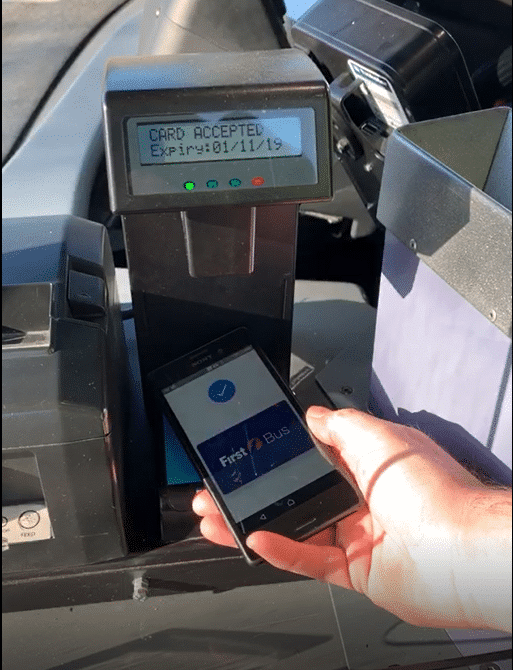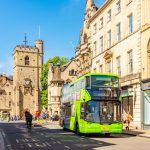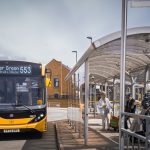There are two questions often asked about BYD and its products: Is it serious, and,
 do they work?

The answer to the first is – deadly serious, and the second, yes!
Says Isbrand Ho, BYD’s MD for Europe: “Electromobility is here today. It’s not something in the future.”
That simple but clear message
is underscored by BYD’s reach across
a number of global markets with electric buses, coaches, taxis, cars and forklifts in operation. It is also the world’s largest mobile phone battery maker.
Nearer home, almost 100 electric buses are already prowling the UK’s streets
in Nottingham and London, most using ADL’s 10.8m Enviro200EV body, now the norm for our island.
A BYD electric double- decker is being developed with ADL, about which more details will be released soon.
Much of this is being driven by the need for cleaner air in cities, and in the UK this trend
is only going to continue, with the expectation of almost 30 Clean Air Zone (CAZ) schemes being in action within the next three years.
Suffering worse pollution than even London, Paris has taken measures that by European standards are tough: Banning diesels.
Going much further than London, it has committed to a zero-emission bus fleet, and will require coaches in the core city centre to be electric.

BYD has already delivered its pre- production coach, and is now in the throes of building a €10m electric bus plant at an extended former Michelin tyre warehouse in France, that will build 200 buses a year.
And, as home-to-school transport in France mainly uses coaches, BYD sees a market here.
Meanwhile in Hungary, BYD’s new bus assembly plant was opened in April, with production of 400 vehicles a year starting later this year. In time, it is also expected
to build complete chassis, meaning that these would be supplied to ADL in Falkirk, rather than from China as at present.
BYD’s European operations are run from its Rotterdam, Netherlands, office.
Close-up
Brochures and vehicles are one thing, but so that BYD’s determination and full intent could be understood, it hosted a trip of 10 specially-selected journalists, including routeone, also representing France, Italy, Spain, the Netherlands, Belgium, Norway, Sweden and Hungary.
BYD has already identified regions that
it believes are most likely to take up the full- scale introduction of electric vehicles, and this specific regional spread of invitees underpins this.

BYD’s HQ is in Shenzhen, just over the border from Hong Kong. This sprawling city, set amongst sub-tropical wooded hills, has 22m inhabitants (London has 9m), and now boasts an all-electric bus network of 5,698 vehicles.
There is also heavy rail and an eight- line 178-mile metro with 199 stations, that continues to expand.
As part of a special Chinese development region, hi-tech industry is the city’s specialism and the scale is mind-boggling by European standards, with numbers to match.
BYD employs 220,000 people of whom 20,000 are engineers and the company, founded as a battery manufacturer in 1995, now has the ‘Sage of Omaha’ Warren Buffet among its investors. I
t is this external investment that has enabled BYD to expand so rapidly and comprehensively. It now has a €15bn annual turnover.
This is much more than a few men in sheds tinkering – but a full-scale business with
four key pillars at its heart: electronics, road vehicles, energy storage and rail.
Its Shenzhen factory is so large that
a monorail – built to demonstrate BYD’s rail intentions – will be extended to encircle the plant, in a 10.3km route.

SkyRail, BYD hopes, will solve mass transit problems, being one- fifth cheaper to build than conventional light rail/metro systems. Its columns can be placed in the central reservations of roads, rather than taking up valuable development land.
Meanwhile, some of the roof of the plant has an 8mW solar array, sufficient to power one-sixth of the factory’s energy usage. This is where another aspect
of BYD’s strength comes in; its storage. At the factory, banks of batteries store electricity, for example while the factory takes its 1130- 1430 lunch, releasing it when required.
Elsewhere in the world, the solution
is containerised, and used to smooth supplies on the grid from solar and wind farms, and provide back-ups.
Battery is core
At the core of everything that BYD does is its battery technology.
It is very proud of its safety and environmental credentials. Of the 30,000 buses it has built, not one has caught fire, or had its batteries explode. And the same goes for other uses of its batteries.

Against the backdrop of Samsung’s self- combusting Galaxy PR disaster, and recent incidences of other firms’ electric cars catching fire, this is important.
BYD places great store by the safety its unique Iron-Phosphate battery technology. Not only is it very safe, it is also sustainable. It doesn’t use precious rare materials in its manufacture and can be fully recycled.
Due to the sensitive nature of industrial secrets, we were unable to photograph much of what we saw.
But we can tell you that the battery manufacturing process, on a line that is a mile long, is all automated, with around 50 people ‘keeping an eye on things’, and
is incredibly clean and very hi-tech.
Similarly, it has full test facilities, where batteries are dropped, crushed, baked
to 150°C, and placed in an open fire. To pass, the battery must not catch fire or explode.
BYD is constantly working on new battery chemistry. It has investigated 300 types, and is about to announce a new formulation.
Wang Chuanfu, 51, is a chemical engineer who founded BYD and is now its Chairman. He has declared war on particulates (PM), but in an environmentally friendly way.
“While BYD’s battery density is not as high as some competitors – although it is still excellent
- it is more important to have a safe and environmentally sound battery. That’s the difference between BYD and others.”
Range
How far a BYD electric will travel is the key question for buyers. In London, where the first of three orders for 89 of the 10.8m BYD/ ADL Enviro200EV are already in service, there have been no surprises.
The routes
are well within the battery’s capacity; the only difference to the ‘as advertised’ product is that electricity consumption has been lower than expected, meaning that running cost predictions can be reforecast lower.
The full 12m BYD electric bus has a range of up to 180 miles or 17 hours a day, depending on duty cycle. BYD’s e6 electric taxi, already in service in London, Brussels, Rotterdam and Barcelona, has a range up to 250 miles, as do BYD’s electric cars.
The latter, although not yet available in Europe, are up to the latest western standards, we discovered during track-based test drives, where we were able to push handling to the limit. In addition to BYD’s own car range, in partnership with Daimler it is producing Denza-branded cars. Isbrand says that
BYD wants to ensure that everything
is spot-on before launching in Europe, as BYD recognises that dealer network, support, spares and marketing need to be tip-top
in the highly-competitive environment.
It’s more than simply selling a car. He hints that Norway may be the first country to see its cars.
Testing, testing
The imminent arrival of Typhoon Hato – rated 10, the highest in the scale – saw Hong Kong and Shenzhen shut down, meaning that our planned trip to see BYD’s main bus building
factory 75 miles away in Shanwei was cancelled.
However, we were able to see the bus prototyping centre in Shenzhen, where new designs undergo pre-production assembly. On the line were artics, due to be delivered to Oslo, Norway.
We were also shown the car crash-testing laboratory; a full size version of that used
for Euro NCAP safety ratings, which includes undercover facilities to stage head-on crashes, along with a phalanx of millions of dollars’ worth of crash test dummies.
BYD also has the largest test houses
in China for electromagnetic compatibility (EMC) testing. The 12m bus inside was dwarfed by the large hall (28mx18m), and the adjacent £7m acoustic chamber (also China’s largest), for testing noise, harshness and vibration, is even bigger at 28mx23m, able to accommodate artics and deckers with ease.
Meanwhile, the Denza car plant is clean, modern and class-leading. Although only
on small-scale production at present, it is able to ramp up to much higher volumes.

Real world
A visit to a depot of the Shenzhen Bus Group demonstrated all-electric bus operation
in China. Around 80% of the 5,698 fleet
is supplied by BYD. With 26,000 employees, the business is no small undertaking, and comprises 967 8.5m midibuses and 4,0000 10.5m buses, with the balance in 33 double- deckers and the rest in 12m buses.
Shenzhen moved from hybrids in 2008, to pure electric in 2011, and in June the last diesel bus was withdrawn, as the entire fleet renewal with electric was completed.
This massive investment, in vehicles
and infrastructure, with 1,174 charging
posts at 74 depots and outstations, has revolutionised air quality in the city, reducing pollution by 430,000 tonnes of CO2 per year. There are 344 routes with a 15-hour/110- mile average duty cycle.
The city, which is converting its taxi fleet
to all-electric by 2020, has now dealt with the worst of its pollution issues, and you can now see clearly.
The future
BYD is a strong, technologically-focused company that has clear aims, across multiple sectors, with battery technology and
battery management systems at its heart.

But it is also one that is environmentally responsible, which is why it chooses a slightly lower battery density, in order to make environmentally-sound batteries that are very safe. It is also proud that it generates no pollution during battery manufacture.
Do not underestimate the rapid pace of development at BYD, nor its desire to be the market’s most significant player.

























